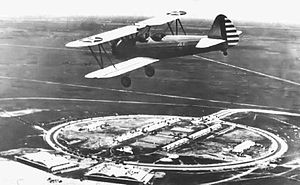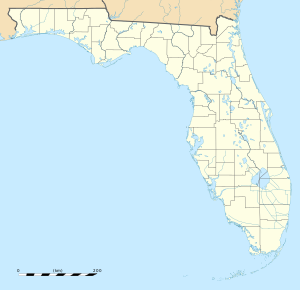Carlstrom Field
| Carlstrom Field | |
|---|---|
| DeSoto County, near Arcadia, Florida | |

A 1942 photo of a Major George Ola in a PT-17 Stearman biplane trainer over Carlstrom Field
|
|
| Coordinates | 27°08′18″N 081°48′10″W / 27.13833°N 81.80278°WCoordinates: 27°08′18″N 081°48′10″W / 27.13833°N 81.80278°W |
| Type | Army Airfield |
| Site information | |
| Controlled by |
|
| Condition | DeSoto County Juvenile Correctional Complex |
| Site history | |
| Built | 1917 |
| In use | 1917-1945 |
| Battles/wars |
World War I World War II |
| Garrison information | |
| Garrison | Training Section, Air Service (World War I) Army Air Force Training Command (World War I) |
Carlstrom Field is a former military airfield, located 6.4 miles (10.3 km) southeast of Arcadia, Florida. The airfield was one of thirty-two Air Service training camps established in 1917 after the United States entry into World War I.
Carlstrom Field was named after 1st Lieutenant Victor Carlstrom.
In 1917 the Army announced its intention of establishing a series of camps to train prospective pilots after the United States entry into World War I. An Army survey crew was sent to Southwest Florida looking for suitable sites to build airfields, one selected was a site about 6 miles to the southeast of Arcadia, Florida. An agreement to lease the land for the Army was concluded, and the construction of some 90 buildings began in January 1918. It covered over 700 acres (2.8 km2) which included fourteen hangars that housed four to eight planes each, a hospital, and six barracks that held 175 men each. Dozens of wooden buildings served as headquarters, maintenance, and officers’ quarters. Enlisted men had to bivouac in tents.
In March, 1918 the 107th and 108th Aero Squadrons was transferred from Rich Field, Waco, Texas and assigned to the new Carlstrom Field. In April the 76th and 109th Aero Squadrons, also arrived from Rich Field, but were subsequently transferred over to Dorr Field; which was designed as an auxiliary sub-field for Carlstrom. Only a few Air Service aircraft arrived from Waco; most of the Curtiss JN-4 Jennys to be used for flight training were shipped in wooden crates by railcar. Carlstrom Field served as an advanced school for pursuit pilots. It offered a six-week course. It had a student capacity of 400.
Squadrons assigned to Carlstrom Field were:
In addition to the training at Carlstrom Field, the pursuit pilot school operated a sub-field, Valentine Field, located at Labelle, Lee County, Florida. Valentine Field was named in honor of 2d Lieutenant Herman W. Valentine, who was killed in an airplane accident at Carlstrom Field on 4 May 1918. Junius Wallace Jones, who later rose to the rank of Major General and was the first Inspector-General of the United States Air Force received his flight training here.
With the sudden end of World War I in November 1918, the future operational status of Carlstrom Field was unknown. Many local officials speculated that the U.S. government would keep the field open because of the outstanding combat record established by Carlstrom -trained pilots in Europe. Locals also pointed to the optimal weather conditions in the Southwest Florida area for flight training. Cadets in flight training on 11 November 1918 were allowed to complete their training, however no new cadets were assigned to the base. Also the separate training squadrons were consolidated into a single Flying School detachment, as many of the personnel assigned were being demobilized.
...
Wikipedia

